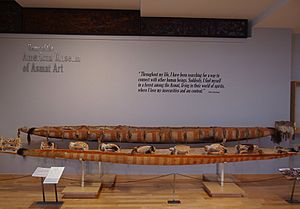American Museum of Asmat Art facts for kids
 |
|
 |
|
| Established | 2007 |
|---|---|
| Location | Anderson Student Center, University of St. Thomas, St. Paul, Minnesota |
| Type | Art museum, anthropology museum |
| Collections | Asmat art |
The American Museum of Asmat Art is a special place in St. Paul, Minnesota. It's located at the University of St. Thomas. This museum shows off the amazing art and culture of the Asmat people. The Asmat people live in a faraway part of Papua, Indonesia. With over 2,200 items, it's one of the biggest collections of Asmat art in the whole United States!
Contents
Discovering Asmat Art
Asmat art is very special and unique. Many big museums around the world want to collect it. Even though it's hard to visit the Asmat region, their art is "exceptionally expressive." This means it shows a lot of feeling and creativity.
What You Can See
The museum has a main display of Asmat artworks. You can see tall ancestor poles, called bis. There are also real canoes used by the Asmat people. The museum also has changing exhibits. These shows highlight different parts of Asmat art and culture.
Exploring Online
A lot of the museum's collection is available online. You can look at many of the artworks from home. This online database helps people learn about Asmat art from anywhere.
The Museum's Founder
The American Museum of Asmat Art was started by a man named Bishop Alphonse Sowada. He was from Minnesota, just like the museum. Bishop Sowada worked with the Asmat people for many years. He started his work there in 1958.
Bishop Sowada's Work
Bishop Sowada was very interested in the Asmat culture. He earned a special degree in cultural anthropology. This is the study of human societies and cultures. He wrote books about Asmat art and their way of life.
Building the Collection
Over time, Bishop Sowada collected hundreds of Asmat artworks. These items became the main part of the museum's collection. He helped create another museum too. In 1973, he helped start the Asmat Museum of Culture and Progress in Agats, Indonesia. This museum was made for the local people.
Supporting Artists
Bishop Sowada also helped start an annual woodcarving competition. This event began in 1981. It takes place every October in Agats. The competition helps recognize talented Asmat carvers. It also includes an auction for their amazing artwork.
Museum's Journey to St. Paul
After many years, Bishop Sowada retired. He returned to the United States. He kept his large collection of Asmat art in different places. First, it was in Hastings, Nebraska. Then, it moved to Shoreview, Minnesota.
Finding a Permanent Home
In 2007, Bishop Sowada gave his entire collection to the University of St. Thomas. This generous gift made the museum possible. The current museum building opened its doors in 2012. It has been a wonderful place to learn about Asmat art ever since.

